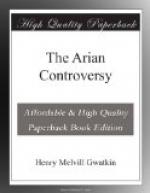[Sidenote: The ‘Dated Creed’ (May 22, 359).]
The ‘Dated Creed’ was drawn up at Sirmium on Pentecost Eve 359, by a small meeting of Homoean and Semiarian leaders. Its prevailing character is conservative, as we see from its repeated appeals to Scripture, its solemn tone of reverence for the person of the Lord, its rejection of the word essence for the old conservative reason that it is not found in Scripture, and above all, from its elaborate statement of the eternity and mysterious nature of the divine generation. The chief clause however is, ’But we say that the Son is like the Father in all things, as the Scriptures say and teach.’ Though the phrase here is Homoean, the doctrine seems at first sight Semiarian, not to say Nicene. In point of fact, the clause is quite ambiguous. First, if the comma is put before in all things, the next words will merely forbid any extension of the likeness beyond what Scripture allows; and the Anomoeans were quite entitled to sign it with the explanation that for their part they found very little likeness taught in Scripture. Again, likeness in all things cannot extend to essence, for all likeness which is not identity implies difference, if only the comparison is pushed far enough. So the Anomoeans argued, and Athanasius accepts their reasoning. The Semiarians had ruined their position by attempting to compromise a fundamental contradiction. The whole contest was lowered to a court intrigue. There is grandeur in the flight of Athanasius, dignity in the exile of Eunomius; but the conservatives fell ignobly and unregretted, victims of their own violence and unprincipled intrigue.
[Sidenote: Western Council at Ariminum.]
After signing the creed, Ursacius and Valens went on to Ariminum, with the Emperor’s orders to the council to take doctrinal questions first, and not to meddle with Eastern affairs. They found the Westerns waiting for them, to the number of more than two hundred. The bishops were in no courtly temper, and the intimidation was not likely to be an easy task. They had even refused the usual imperial help for the expenses of the journey. Three British bishops only accepted it on the ground of poverty. The new creed was very ill received; and when the Homoean leaders refused to anathematize Arianism, they were deposed, ’not only for their present conspiracy to introduce heresy, but also for the confusion they had caused in all the churches by their repeated changes of faith.’ The last clause was meant for Ursacius and Valens. The Nicene creed was next confirmed, and a statement added in defence of the word essence. This done, envoys were sent to report at court and ask the Emperor to dismiss them to their dioceses, from which they could ill be spared. Constantius was busy with his preparations for the Persian war, and refused to see them. They were sent to wait his leisure, first at Hadrianople, then at the neighbouring town of Nice (chosen to cause confusion with Nicaea), where Ursacius and Valens induced them to sign a revision of the dated creed. The few changes made in it need not detain us.




